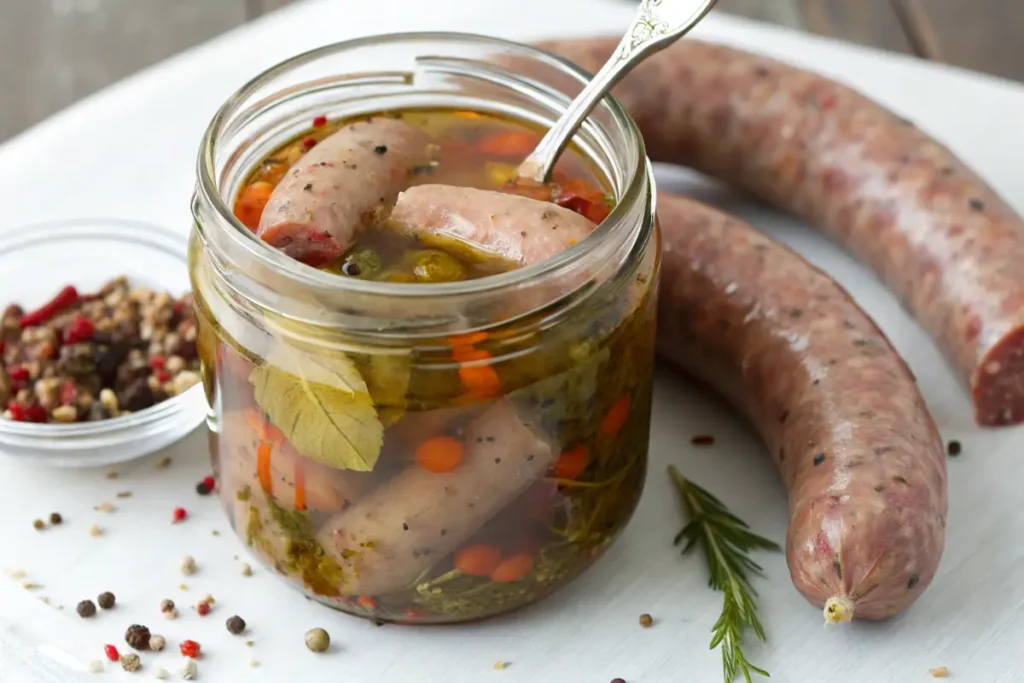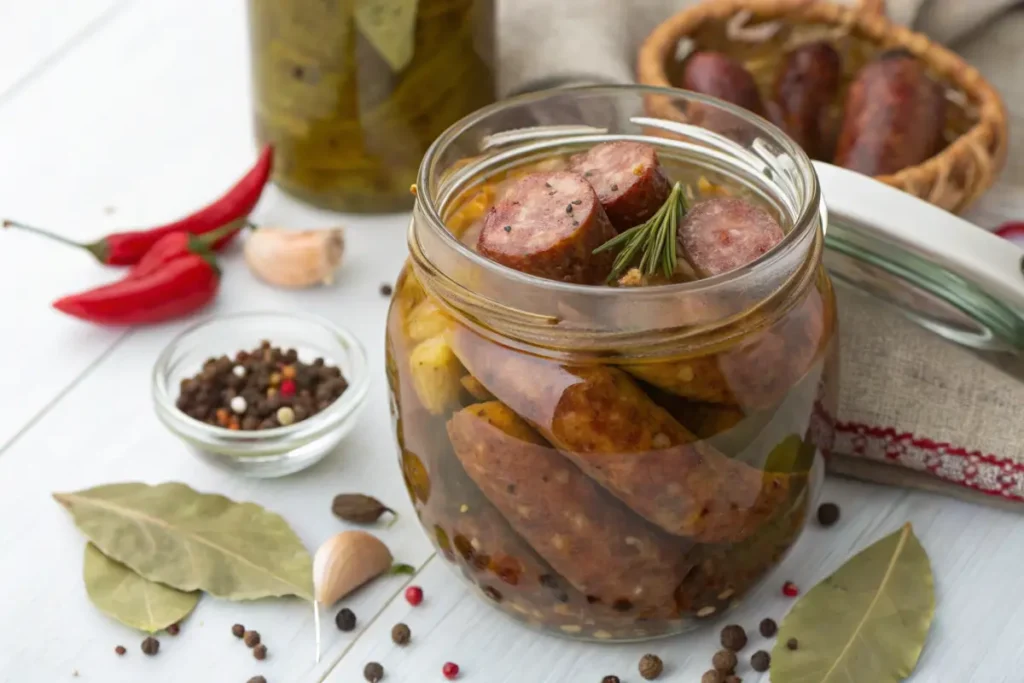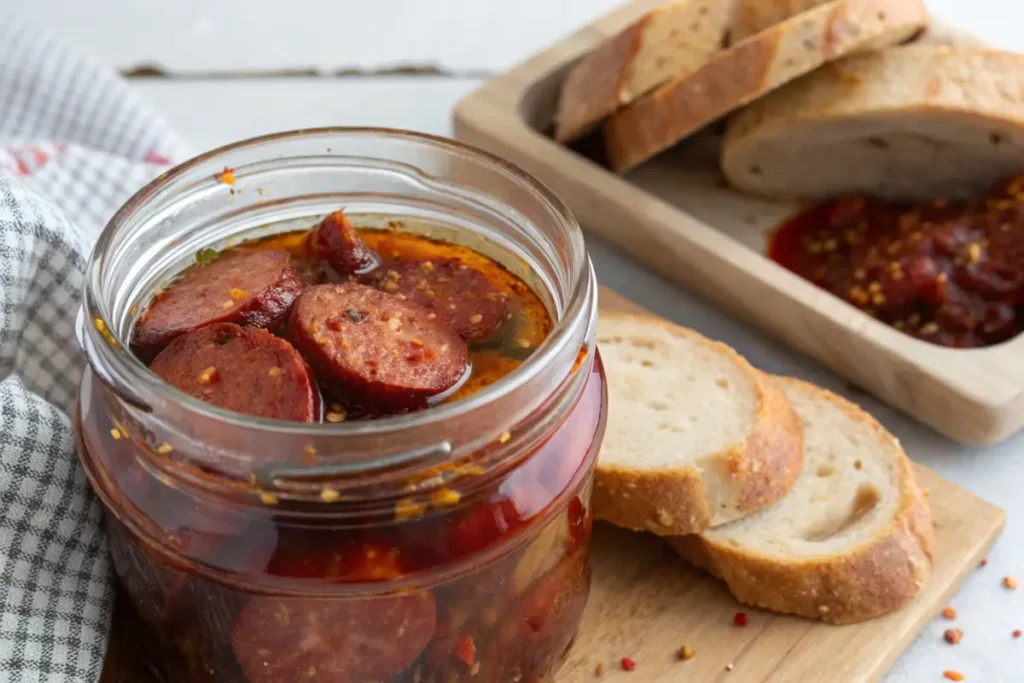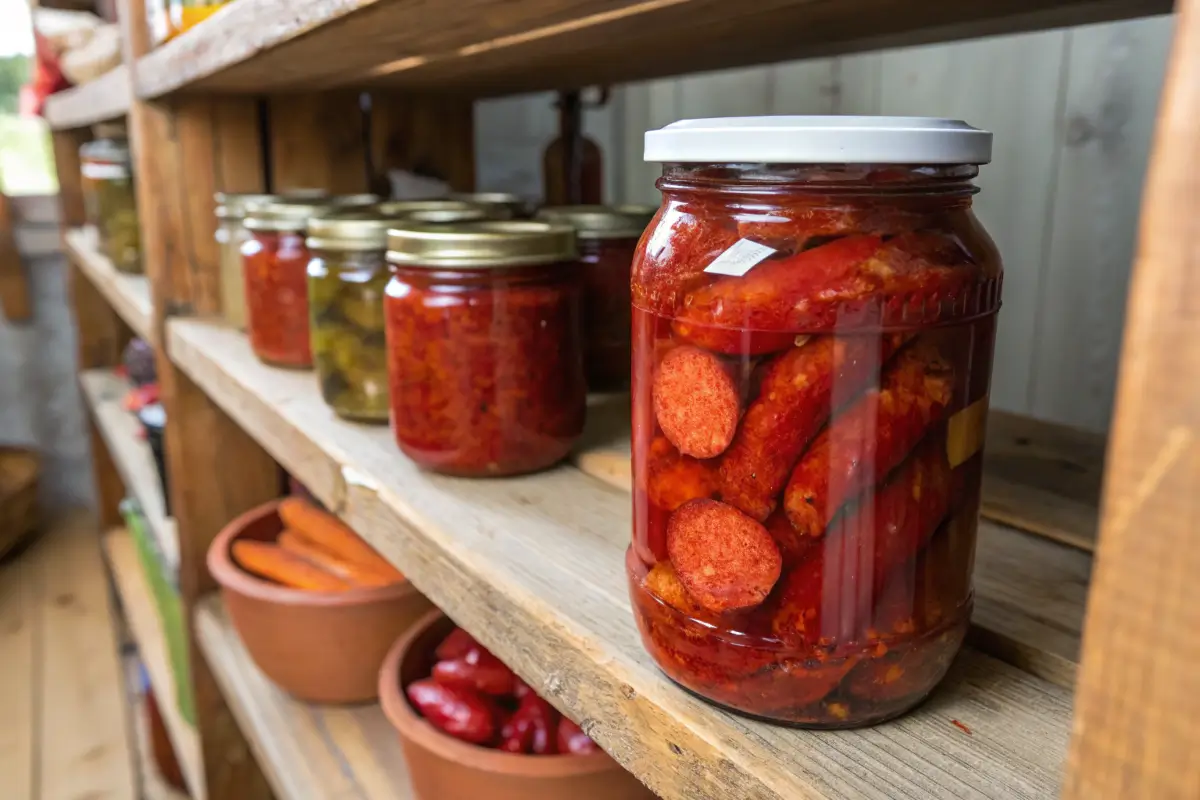Reading time: 11 minutes
Pickled sausage is a tangy, flavorful snack cherished by many for its bold taste and satisfying texture. This unique food combines savory sausage with a briny pickling solution, resulting in a zesty treat that tantalizes the palate. Its popularity stems from its simplicity and versatility, making it a staple in households and convenience stores alike.
The appeal of this snack lies in its ability to balance saltiness, acidity, and spices in every bite. Whether enjoyed as a standalone treat, paired with crackers, or used to enhance recipes, it offers something for everyone. Furthermore, its long shelf life and ease of preparation contribute to its widespread appeal. As more people look for ways to preserve and enhance everyday ingredients, pickled sausage continues to gain recognition as both a nostalgic and modern culinary delight.
Table of contents
- A Step-by-Step Guide to Making Pickled Sausage at Home
- The Best Sausages to Use for Pickling: Tips and Tricks
- How Long Does It Take to Make Pickled Sausage?
- Health Benefits of Pickled Sausage: Is It a Healthy Snack Option?
- The History of Pickled Sausage: From Tradition to Modern Tables
- Top 5 Flavor Variations for Pickled Sausage You Need to Try
- Pickled Sausage for Beginners: Avoiding Common Mistakes
- How to Store Pickled Sausage for Maximum Freshness
- Pickled Sausage Recipes from Around the World
- Best Side Dishes and Snacks
- Can You Make Pickled Sausage Without Vinegar? Exploring Alternatives
- Why Pickled Sausage Is Perfect for Parties and Gatherings
- The Ultimate Guide to Homemade Pickled Sausage Jars
- Conclusion
- FAQs
A Step-by-Step Guide to Making Pickled Sausage at Home
Making these sausage at home is a straightforward and rewarding process. You’ll need just a few ingredients and tools to get started. Follow these simple steps for delicious results:
- Prepare the Sausages: Choose fully cooked sausages and cut them into smaller pieces for easy pickling.
- Make the Brine: In a pot, combine vinegar, water, salt, and your choice of spices such as garlic, pepper, and bay leaves. Bring the mixture to a boil and let it cool slightly.
- Pack the Jars: Place the sausage pieces into sterilized jars, layering them with any optional flavorings like chili flakes or onions.
- Add the Brine: Pour the warm brine over the sausages, ensuring they are fully submerged.
- Seal and Store: Close the jars tightly and refrigerate for at least 2 days before enjoying.
These steps ensure that the sausages absorb the brine’s tangy, flavorful essence, creating a snack that’s as easy to make as it is to enjoy. For more inspiration on sausage-based recipes, check out this Creamy Parmesan Italian Sausage Soup.
The Best Sausages to Use for Pickling: Tips and Tricks
Choosing the right sausage is critical to making great pickled sausage. Since the brine enhances the flavor, the sausage you select should complement the tangy and spicy elements.
Recommended Options
- Smoked Sausages: Their rich, robust taste pairs perfectly with the acidity of the brine.
- Beef Sausages: These offer a hearty texture that holds up well in the pickling process.
- Spicy Sausages: Adding heat to the pickling process results in a bold, exciting flavor.
Tips
- Pre-Cooked Options: Always use pre-cooked sausages to ensure safety and consistency.
- Quality Ingredients: Opt for high-quality sausages without fillers to achieve the best results.
- Size Matters: Cut sausages into uniform pieces for even pickling.
By selecting the right sausage, you can elevate your homemade pickled sausage to a snack that’s full of flavor and perfectly preserved. For more tips on selecting quality ingredients, explore this Best American Breakfast Guide.
How Long Does It Take to Make Pickled Sausage?
Patience is key when making these sausage. While the process itself is quick, the waiting period is where the magic happens. Typically, you’ll need at least 2 days for the sausages to soak in the brine and absorb its flavors. However, many enthusiasts recommend waiting up to a week for a more intense taste.
The pickling time depends on factors such as the sausage size and the brine’s spice level. Smaller sausage pieces may pickle faster, while larger ones benefit from extended soaking. During this time, keep the jars refrigerated to ensure freshness and food safety.
If you’re eager to enjoy your creation, taste a piece after 48 hours. For those who prefer a deeper, more robust flavor, let the jars sit longer. The wait will be worth it as the flavors intensify over time. For more ideas on preserving and enhancing flavors, check out this Soup Bone Recipe.

Health Benefits of Pickled Sausage: Is It a Healthy Snack Option?
While pickled sausage is often enjoyed as a treat, it offers some surprising health benefits when consumed in moderation. The pickling process enhances the sausage with vinegar and spices, which may have positive effects on digestion and overall health.
Potential Benefits
- Rich in Protein: Sausages provide a satisfying source of protein, essential for muscle repair and energy.
- Low-Carb Option: With minimal carbohydrates, it fits well into low-carb and keto-friendly diets.
- Probiotic Potential: If fermented brines are used, they may promote gut health.
Considerations
- Moderation Is Key: Due to its sodium content, it’s best to enjoy pickled sausage in small portions.
- Customize Your Recipe: Control the salt and spices in your homemade version to tailor it to your dietary needs.
While it may not be a health food, pickled sausage can be a balanced snack when incorporated thoughtfully into your diet.
The History of Pickled Sausage: From Tradition to Modern Tables
The roots of pickled sausage trace back to traditional preservation methods used long before refrigeration. Pickling meat allowed communities to store food for extended periods while enhancing its flavor. Over time, the tangy, spicy snack became a beloved staple in taverns and roadside stops.
Today, pickled sausage retains its nostalgic charm while evolving to meet modern tastes. It’s no longer just a practical food but also a culinary trend. From home kitchens to gourmet food markets, this snack continues to bridge the gap between heritage and innovation.
Understanding the history provides insight into why it remains a timeless favorite, celebrated for both its practicality and bold taste.
Top 5 Flavor Variations for Pickled Sausage You Need to Try
One of the joys of making these sausage is experimenting with different flavor profiles. Here are five variations to inspire your next batch:
- Spicy Jalapeño: Add sliced jalapeños for a fiery kick.
- Garlic Herb: Infuse the brine with fresh garlic and rosemary.
- Sweet and Tangy: Include a touch of sugar and sliced onions for a balanced flavor.
- Cajun Spice: Use paprika, cayenne, and thyme for a Southern-inspired twist.
- Smoky Chipotle: Add chipotle peppers for a deep, smoky flavor.
These variations showcase the versatility of pickled sausage, allowing you to create a snack that suits your preferences while keeping it exciting and flavorful.
By combining practicality with creativity, pickled sausage continues to shine as a snack that’s easy to make, customize, and enjoy.
Pickled Sausage for Beginners: Avoiding Common Mistakes
Making pickled sausage is simple, but beginners often encounter common pitfalls that can affect the final product. Avoiding these mistakes ensures a delicious and safe result.
One common error is using raw sausage instead of pre-cooked varieties. Raw sausage can spoil easily and compromise the pickling process. Another mistake is failing to sterilize jars properly, which may lead to contamination and shorten shelf life. Always wash jars and lids in hot, soapy water and boil them for a few minutes to ensure cleanliness.
Overcrowding sausages in jars can also hinder the brine from fully covering each piece. Ensure there’s enough space for the brine to circulate. Lastly, avoid skipping refrigeration, as pickled sausage should always be kept cold for safety and flavor preservation. By keeping these tips in mind, beginners can master the art of pickling with confidence.

How to Store Pickled Sausage for Maximum Freshness
Proper storage is essential for maintaining the quality and safety of sausage. Once prepared, the jars should always be refrigerated. The cold temperature slows bacterial growth and helps preserve the sausage’s flavor and texture.
Ensure jars are tightly sealed to prevent air from entering, which could lead to spoilage. Label jars with the preparation date to track freshness, as pickled sausage is best enjoyed within one to two months. While the snack is safe to eat for longer if properly stored, the flavor and texture may diminish over time.
If you notice any cloudiness in the brine, mold, or an off smell, discard the contents immediately. For long-term storage, consider using vacuum-sealed jars and ensuring brine covers all sausage pieces completely. With these storage practices, you can keep your pickled sausage fresh and ready to enjoy.
Pickled Sausage Recipes from Around the World
They isn’t just a local favorite; it has variations inspired by global cuisines. These recipes showcase how different regions add unique twists to the classic snack.
- German-Inspired Pickled Sausage: Incorporates mustard seeds, caraway, and dill for a bold, tangy flavor.
- Mexican-Style Pickled Sausage: Features spicy peppers like jalapeños and a hint of lime for a fiery kick.
- Asian-Infused Pickled Sausage: Uses soy sauce, ginger, and rice vinegar to create a savory, umami-rich taste.
- American Southern Pickled Sausage: Includes Cajun spices like paprika, thyme, and cayenne for a smoky heat.
- Mediterranean Pickled Sausage: Combines oregano, garlic, and lemon for a bright, aromatic flavor profile.
These recipes highlight the versatility of pickled sausage and how cultural influences can transform a simple snack into a global delicacy.
Best Side Dishes and Snacks
Pickled sausage is a versatile food that pairs beautifully with a variety of sides and snacks. Its tangy flavor and firm texture complement both savory and light accompaniments.
For a crunchy contrast, serve pickled sausage with crackers, breadsticks, or a fresh vegetable platter. Pairing it with cheeses such as cheddar or gouda creates a balanced snack board. If you prefer heartier options, include it alongside roasted potatoes or grilled vegetables.
For a zesty flavor boost, serve pickled sausage with dipping sauces like spicy mustard or ranch dressing. It’s also a great addition to salads, offering a salty, tangy element to leafy greens or pasta dishes. These pairings elevate the experience, making the snack even more enjoyable.
Can You Make Pickled Sausage Without Vinegar? Exploring Alternatives
Vinegar is a key ingredient in traditional pickled sausage recipes, but there are alternative methods for those seeking a different approach. These substitutes can achieve a similar tangy effect while offering unique flavors.
One option is to use lemon or lime juice, which provides natural acidity and a bright, citrusy taste. Another alternative is fermentation, where sausages are preserved in a brine made from water and salt. This method relies on natural bacterial processes to create a tangy flavor.
For a milder taste, consider using sour whey, a byproduct of yogurt or cheese-making, which adds subtle tartness. Whichever method you choose, ensure proper food safety measures are followed to preserve freshness and prevent spoilage. These alternatives showcase the adaptability of pickled sausage, catering to diverse tastes and dietary needs.

Why Pickled Sausage Is Perfect for Parties and Gatherings
Pickled sausage is an ideal addition to any party or gathering, thanks to its bold flavor and versatility. It’s a crowd-pleaser that pairs well with various snacks and drinks, making it a staple for casual and formal events alike.
One of its greatest strengths is its ease of preparation. You can make it in advance and store it until party day, freeing up time for other tasks. Its long shelf life also means no last-minute rush to prepare.
Arrange them on a charcuterie board alongside cheeses, crackers, and vegetables for an eye-catching spread. Its tangy taste pairs well with beverages, especially sodas and non-alcoholic punches. For themed events, you can customize the brine to match specific flavor profiles. These qualities make these sausage a reliable and versatile party food option.
The Ultimate Guide to Homemade Pickled Sausage Jars
Creating the perfect jar involves attention to detail, from selecting the right ingredients to ensuring proper storage. A well-made jar not only enhances flavor but also ensures safety and longevity.
Start by choosing high-quality sausages and a brine recipe suited to your taste. Use sterilized glass jars with airtight lids to prevent contamination. When layering sausages and spices, leave enough space for the brine to circulate.
Fill the jars with warm brine, ensuring sausages are fully submerged. Remove air bubbles by tapping the jar lightly or using a utensil. Seal the jars tightly and store them in the refrigerator. Proper labeling, including the preparation date, helps track freshness.
By following these steps, you can create a homemade jar of pickled sausage that’s as visually appealing as it is delicious.
Conclusion
Whether you’re a seasoned cook or a curious beginner, pickled sausage is a delightful addition to your culinary repertoire. Its tangy, bold flavor makes it a versatile snack, perfect for sharing or enjoying solo. With easy preparation, storage, and countless customization options, it’s a snack that fits seamlessly into any lifestyle.
By experimenting with brine ingredients, sausage types, and serving ideas, you can make each batch uniquely your own. From parties to everyday snacks, pickled sausage brings a burst of flavor to every occasion. Start your pickling journey today and discover why this timeless treat remains a favorite for so many.
FAQs
Pickled sausages are not particularly healthy due to their high sodium content and preservatives. Enjoy in moderation.
Pickled sausages are typically made from cured sausages soaked in a vinegar-based brine with spices.
If stored properly in the fridge, pickled sausages can last for several weeks to a few months.
They can be eaten directly from the jar as a snack or added to salads, sandwiches, or charcuterie boards.

